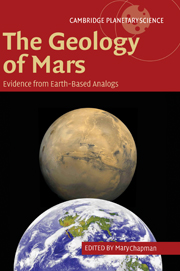Book contents
- Frontmatter
- Contents
- Preface: the rationale for planetary analog studies
- List of contributors
- 1 The geology of Mars: new insights and outstanding questions
- 2 Impact structures on Earth and Mars
- 3 Terrestrial analogs to the calderas of the Tharsis volcanoes on Mars
- 4 Volcanic features of New Mexico analogous to volcanic features on Mars
- 5 Comparison of flood lavas on Earth and Mars
- 6 Rootless volcanic cones in Iceland and on Mars
- 7 Mars interior layered deposits and terrestrial sub-ice volcanoes compared: observations and interpretations of similar geomorphic characteristics
- 8 Lava—sediment interactions on Mars: evidence and consequences
- 9 Eolian dunes and deposits in the western United States as analogs to wind-related features on Mars
- 10 Debris flows in Greenland and on Mars
- 11 Siberian rivers and Martian outflow channels: an analogy
- 12 Formation of valleys and cataclysmic flood channels on Earth and Mars
- 13 Playa environments on Earth: possible analogs for Mars
- 14 Signatures of habitats and life in Earth's high-altitude lakes: clues to Noachian aqueous environments on Mars
- 15 The Canyonlands model for planetary grabens: revised physical basis and implications
- 16 Geochemical analogs and Martian meteorites
- 17 Integrated analog mission design for planetary exploration with humans and robots
- Index
- Plate section
- References
13 - Playa environments on Earth: possible analogs for Mars
Published online by Cambridge University Press: 18 September 2009
- Frontmatter
- Contents
- Preface: the rationale for planetary analog studies
- List of contributors
- 1 The geology of Mars: new insights and outstanding questions
- 2 Impact structures on Earth and Mars
- 3 Terrestrial analogs to the calderas of the Tharsis volcanoes on Mars
- 4 Volcanic features of New Mexico analogous to volcanic features on Mars
- 5 Comparison of flood lavas on Earth and Mars
- 6 Rootless volcanic cones in Iceland and on Mars
- 7 Mars interior layered deposits and terrestrial sub-ice volcanoes compared: observations and interpretations of similar geomorphic characteristics
- 8 Lava—sediment interactions on Mars: evidence and consequences
- 9 Eolian dunes and deposits in the western United States as analogs to wind-related features on Mars
- 10 Debris flows in Greenland and on Mars
- 11 Siberian rivers and Martian outflow channels: an analogy
- 12 Formation of valleys and cataclysmic flood channels on Earth and Mars
- 13 Playa environments on Earth: possible analogs for Mars
- 14 Signatures of habitats and life in Earth's high-altitude lakes: clues to Noachian aqueous environments on Mars
- 15 The Canyonlands model for planetary grabens: revised physical basis and implications
- 16 Geochemical analogs and Martian meteorites
- 17 Integrated analog mission design for planetary exploration with humans and robots
- Index
- Plate section
- References
Summary
Introduction
Playas (dry lakes) are a type of lacustrine system that are dry most of the time, and can be flooded only occasionally. A playa environment, despite its dry conditions, is characterized by an active hydrological cycle. This is evidenced by a wide range of hydrogeological processes operating today or in the recent past. Therefore, playas are a fundamentally different environment from dry desiccated deserts, and identification of playas on Mars has significant implications for the planet's hydroclimatic history.
Mars currently is dominated by a hyperarid environment. Today, water appears to exist abundantly in the Martian polar caps, and also in the surrounding high-latitude regions, but as near-surface ice (Boynton et al., 2002), not liquid water. Whether or not there are localities with recent active hydrogeological processes is uncertain. However, there may have been sites of stable lakes (deep-water lakes) in the past. Such sites would have changed to playa environments, owing to the decline in the water budget, and eventually desiccated completely. Photogeologic surveys have identified possible paleoshorelines in the northern plains (Parker et al., 1989) and crater lakes (Cabrol and Grin, 1999; Ori et al., 2000a; Malin and Edgett, 2003). If these features are in fact paleoshorelines, it would necessarily imply that conditions suitable for stable oceans and lakes must have existed at some point in Mars' history. Ice-covered paleolakes could have also existed, and their shoreline geomorphology could differ from that of paleolakes without ice cover.
- Type
- Chapter
- Information
- The Geology of MarsEvidence from Earth-Based Analogs, pp. 322 - 348Publisher: Cambridge University PressPrint publication year: 2007
References
- 12
- Cited by

